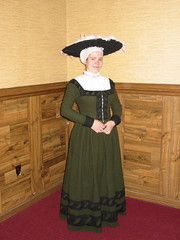This is my finished early 16th c. German common woman's outfit. I'm very pleased with how everything turned out. Gown is heavy wool and trimmed in a lighter wool, with bodice lined and interlined in linen; sewn with silk and some linen thread and closes with hooks and eyes. Hemd (chemise) is lightweight linen, sewn with linen and smocked with black silk embroidery thread; closes with two pairs of hooks and eyes at the neck. Hat is wool bedecked in ostrich feathers, shape held by 8 gauge copper wire. The set-up under the hat is a fine example of last-minute materials-on-hand costuming - I'm using a couple of skeins of wool yarn to create the wulst bulge (fake braids would be preferable - easier to arrange and less squishy) and the veil over it is neither the right size or shape (but workable with enough pins and patience). The gown and hat used patterns from Reconstructing History; the chemise is my own design.
Subscribe to:
Post Comments (Atom)

4 comments:
May I ask about your pattern of the Hemd? I'm looking to make a high necked camica for an Italian working class, and they show pleats all around the neckline, though not as densely as your hemd.
I respect that this is your design and work, and as such I don't expect full disclosure.
Your work is gorgeous Also! That cutwork on the hem is Luxe!
I'm happy to share my designs; I only meant to distinguish that it isn't what you would get from the RH pattern.
I saw the basic idea for the hemd design on the net somewhere, but I cannot now find it. It is a very simple rectangular construction - very wide panels for the front and back, rectangular sleeves, and large square gussets. The assembly is a little unusual, though. The neckline is a continuous straight edge, with no corners going front-sleeve top-back-sleeve top-front. So the sleeves are sewn directly to the sides of the main panels for several inches before the gussets are inserted. When it's pleated, the seamlines look as if you've done raglan sleeves (diagonals from neck to underarm), but they're just straight edges.
Because the neck is one continuous edge, its very easy to pleat (and do smocking if called for). However there are some drawbacks. The garment ends up being symmetrical front to back, but our necks aren't symmetrical, which means my hemd pulls a fair bit in the back between the neck and underarm, pulling the neckline lower than I intended (doesn't show in a head-on photo). If I do another similar one, I'll play with the size, shape and placement of the gusset to see if that helps, but it might not be enough. It might be necessary to make the sleeves not quite rectangular, but have the top edge sloped, so the back of the garment can be a bit higher than the front. (The back panel would then need to be a little longer too.)
If my description has been more confusing than helpful, I can take measurements from the hemd and do a figure at some point.
hi. love all the things you've made.. I'm thinking of making a kampfraudress also, and love your design. Do you have the patterns to that? and want to share them? Or do you know were i can buy the same..
You can e-mail me at hellen678@hotmail.com..
//Helena
Hi Helena - as it says directly in the body of the post above your comment, I used a pattern from Reconstructing History, which can be purchased directly from www.reconstructinghistory.com or one of their many distributors.
Post a Comment